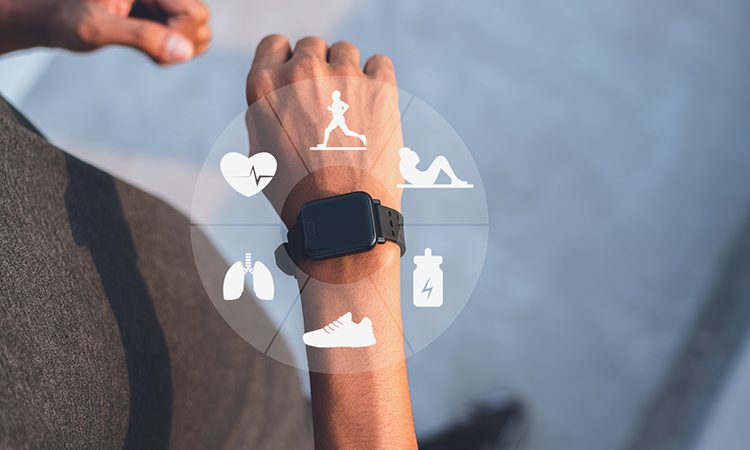You’ve heard of wearable fitness devices. You may own one or three. Over the years, these trackers have blossomed into very detailed training devices. But you can keep it simple, too. Let’s dive into the wonderful world of 21st-century wearable fitness devices.
Fitness devices have come a long way. What once was a simple watch to tell time and had a stopwatch is now the watch that can tell you heart rate and calories burned, not to mention act as your phone.
If you are considering buying one of these handy devices, how do you know which will be right for you without overpaying for features you don’t need? The ins and outs of wearable fitness devices will become apparent here.
Level One Wearable Fitness Trackers
First, decide what you need the device to help you with. If you want to track how many steps you take to become more active in a day, then a basic wearable device will suffice. A brand like Fitbit is well-known and has an affordable entry-level watch that can be purchased for around $70.
Although watches are the most common wearable device, Fitbit also has wearable fitness tracker options that don’t need to be worn on the wrist. Some clip onto waistbands, your shoelace or are worn around the bicep. As massage therapists, we know to leave our forearms bare, so this type of device may appeal to some.
Level Two Wearable Fitness Trackers
Next are those devices that can track heart rate and sleep patterns. Monitoring heart rate during exercise is common for those working to improve the strength of their heart. Different target heart rates for fat burning, high intensity, and steady rate cardiovascular fitness exist. Your wearable device with heart rate monitor makes it easy to look down and know if you are where you should be. When a heart rate is too low, you learn to pick up the intensity, and when a heart rate is too high, you can back off.
You need to wear your fitness watch to bed to track your sleep. Some people find this uncomfortable, so it’s something to consider if you want to improve your sleep patterns and you want your wearable fitness tracker to have this feature.
Garmin makes many levels of capable fitness watches. One with a heart rate monitor may cost around $200.
The Highest-Priced Watches Have the Most Features
The next category of wearable fitness trackers are the multi-sport watches and the watches that act as your phone.
The multi-sport watch by Garmin, for example, can count laps in the pool and use GPS for open-water swims, bike rides and running routes. Knowing how far you’ve traveled is helpful, and returning to your car when hiking or mountain biking is handy. If you venture off the path, simply follow the line back to your vehicle. As long as there is a wi-fi signal, it’s hard to get lost.
Would you like to keep track of all workouts? The Garmin watch can do that. You can record the type of workout, length of workout, heart rate during a workout, calories burned and more.
The app associated with your fitness watch uploads your watch data and lets you see your workouts in one place. This makes it easy to follow your progress and plan future workouts.
Garmin watches have a wide-ranging price tag of $300-900. Again, this is why you pay for what you need or want.
Apple watches are popular and have the features of your cell phone. The Apple watch may be more than you need for fitness tracking alone, but it’s an option as long as you silence notifications during your massage sessions. There is no need to lose focus from the client to vibrating IG notifications that aren’t important. The Apple Watch starts at around $300 and increases in cost with more features added.
Other features in fitness trackers are reminders to get up and move, stretch, breathing reminders, a hydration tracker, menstrual cycle tracking and even guided meditation.
Where Do You Wear the Device During a Session?
A minor drawback to using a watch for your fitness tracker is the need for massage therapists to leave their forearms bare while working. I hope you use your forearms as a tool. The watch needs the sensors on the bottom of the watch face to connect to your skin to get readings like calories burned, heart rate and stress levels.
In the past, I would put my fitness watch on my holster as I went into session. It would still count my steps, but I lost all other features like heart rate and calories burned.
A massage therapist I know solved this problem by finding a stretchable watch band that slides over her foot. This band allows her to wear her fitness watch on her ankle while keeping all watch functions available. I love that idea.
If you want better health, a wearable fitness device is handy, and it is fun for those who like numbers and data. The numbers hold you accountable and let you see progress. If this motivates you to stick to your movement goals, the wearable device is worth the money. You might be burning more calories than you think after doing four massages.
Take advantage of 21st-century technology and get a wearable fitness tracker. Staying healthy in this profession is something I always talk about. The better you care for yourself, the longer you can be a massage therapist. Think about what wearable fitness tracker might be good for you. Let me know how you like yours at thefitmt@gmail.com.
About the Author
Angela Lehman is a massage therapist of 25 years turned online educator, promoting fitness and nutrition for massage therapists. She runs The Fit MT. With her kinesiology degree specialized in nutrition, she trains therapists in healthy eating, exercise and body mechanics to prolong their careers.
